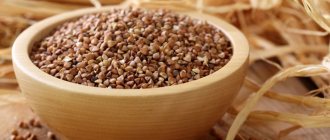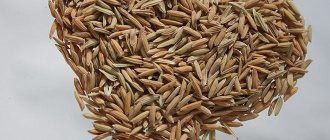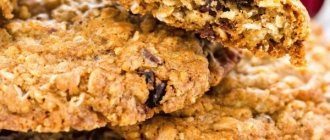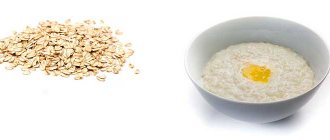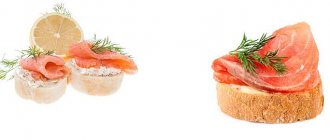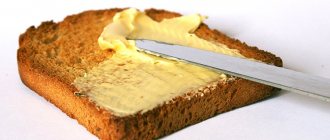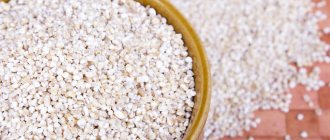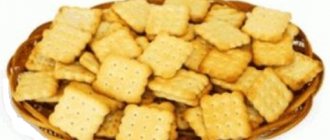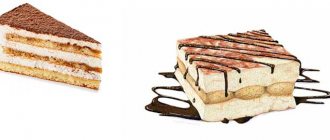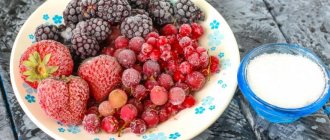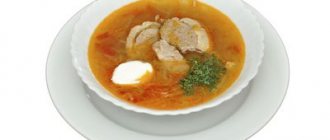There are many types and recipes for making cookies; they can be fragrant and rich, hard and dry, sweet or salty, but almost always they remain forbidden. Forbidden for those who watch their figure, because any cookie is a high-calorie product. Or not, and there are cookies that you can eat even while on a diet? In this article we will look at the calorie content of different types of cookies, and at the same time we will figure out what kind of baked goods you can treat yourself to without worrying about your slimness.
- Composition and BJU of cookies
- Calorie content of cookies
- Oatmeal cookies - calorie content 1 piece per 100 grams
- How many calories are in biscuits?
- Energy value of sand product
- How many calories are in puff pastry?
- Nutritional value of sugar cookies
- Biscuits of famous brands - calorie content per 100 grams
- What cookies can/cannot be eaten on a diet?
The most popular cookies are oatmeal cookies!
Hot, fresh oatmeal cookies are especially popular among our population. With tea and milk, with kefir and a cup of coffee - oatmeal cookies are a classic not only for children, but also for adults. Neither newfangled chocolates and waffles could lure our people over, because the classic taste of these cookies cannot leave our minds alone.
In addition, this delicacy is especially good for those who want to adhere to a healthy lifestyle, so today there is a huge variety of this product - with sesame seeds, without sugar, with raisins, with honey and nuts, with poppy seeds and other additives.
Can oatmeal cookies make you fat?
Of course you can, if you eat tons of it - just like everything else.
Although among all other types of cookies this is almost the safest type for the figure. In this case, you need to pay great attention to the composition of this product - if margarine was used in its preparation, then you have a much greater chance of gaining weight. In addition, any product cannot be initially dietary if flour, sugar, eggs, butter or margarine were used in its preparation. In any case, we can tell you for sure that people get fat not because they eat, but because they move very little.
So, let's take the classic round oatmeal cookies, they are sold in various places by weight.
Calorie content
As a rule, such cookies weigh about nineteen to twenty grams, which means they contain about eighty-four calories.
So decide for yourself whether you should eat it or look at another cookie.
Calorie content of oatmeal cookies
It’s not for nothing that we used the title in the plural; there are several types of oatmeal cookies, the calorie content of which, for this reason, is also completely different.
The calorie content of oatmeal cookies is high - 440 kcal per 100 grams. On average, 1 piece weighs 27 grams, respectively, the approximate calorie content of 1 oatmeal cookie is 140 units. At the same time, the product is useful for digestion, because it contains a lot of fiber. Coarse dietary fiber cleanses the intestinal walls, stimulates its functioning, fills the stomach, giving a feeling of fullness. Therefore, confectionery products prepared with the addition of oatmeal are sometimes consumed even on a diet. But for weight loss, it is better to enjoy dietary varieties of oatmeal cookies. To prepare it, wheat flour is diluted with rye, oat, or wholemeal flour. You can buy oatmeal in a store, or you can get it yourself by simply grinding oatmeal in a coffee grinder. Sometimes wheat flour is not used at all, so oatmeal cookies will be even less nutritious. The recipe does not include the use of butter or even sugar. Sweetness is obtained by adding honey.
To make your own oatmeal cookies, you will need:
- Glass of oatmeal
- 2 tbsp. honey
- 2 egg whites
- A little salt
Such cookies will have a calorie content of 345 units. per 100 grams. It will be harsh and not very sweet, but it will be as healthy as possible. If you add butter or vegetable oil, wheat flour, kefir, chocolate or dried fruits to the recipe, the product will be more tasty, but not as dietary.
Cookies are quite a high-calorie treat
Every type of cookie involves the addition of flour to its dough, which makes it not safe enough for the figure. And we all dream of a good figure that could attract the gaze of men, because only a small number of women are endowed with this wealth by nature. So most of us have to sacrifice quite a lot and constantly deny ourselves something.
So let's figure out how many calories there are in cookies. To do this, you need to understand which types of cookies are in particular demand, because depending on the type of cookie they have different calorie content.
Recipe for making biscuits at home and its calorie content
To prepare biscuits you need the following ingredients:
- Milk 1.5% or water – 100 ml;
- Sugar or fructose – 40 g;
- Vanillin – 1 tsp;
- Lemon juice – 1 tbsp;
- Corn starch – 40 g;
- Coarse wheat flour – 40 g;
- Premium wheat flour – 160 g;
- Soda – 0.25 tsp;
- Refined sunflower oil – 30 ml.
The calorie content of biscuits prepared with water and fructose is 300 kcal. Sugar - 40 g or fructose must be dissolved in milk or water, then add 30 ml of refined oil. If milk and sugar are used in preparation, then the calorie content of the cookies will be 357 kcal. Next, premium and coarsely ground wheat flour is added to the resulting liquid. Everything is mixed well. Then corn starch and vanillin are poured into the semi-finished dough, and a quarter tsp is also quenched. soda and lemon juice. The dough is thoroughly kneaded and left to rest for half an hour or an hour. The finished dough is rolled out into a thin layer, approximately 2 mm thick, and cut into any shape (circles, squares or stars). Each cookie is pierced several times with a fork and placed on a baking sheet, greased and sprinkled with flour or semolina. Prepare homemade biscuits, the calorie content of which is 40 kcal per piece, for 7-10 minutes in the oven preheated to 180°C. Ready-made cookies can be combined with hot chocolate, honey, any jam or jam.
Energy value of cookies from famous manufacturers
Cookies "Yubileinoe" are a bright representative of sugar cookies. The product is well known to almost all Russians; the packaging and characteristic taste are familiar from childhood. The delicacy has many fans, because it melts in the mouth, has a delicate structure, and is easy to snack on. However, not everyone knows that the product is high in calories. Jubilee cookies have a calorie content of about 472 units per 100 grams. One cookie weighs approximately 14 grams, therefore, the calorie content of 1 piece of Yubileiny is 57 units.
- Jubilee Morning Cookies - calorie content 457 units per 100 g
- Cookies Maria calorie content – 400 kcal per 100 g. Biscuits are made from premium quality wheat flour. The energy value of 1 Maria cookie is about 40 kcal (approximate weight 10 grams)
- Yashkino cookies - calorie content 500 units per 100 g
- Approximate calorie content of Lyubyatovo cookies (Maria biscuits and crackers) – 410 units
- Oreo cookies - calorie content 500 units per 100 grams
Calorie content of shortbread cookies
One cookie that is definitely not dietary is shortbread. It has a very delicate, fragile structure, a very sweet taste, literally melts in your mouth. The price for this pleasure is high calorie content, because the confectionery product contains wheat flour, egg yolks, a lot of butter or margarine, to which sour cream or cottage cheese can also be added. Remember the appearance and taste of the famous kurabiye cookies, which are a prominent example of a confectionery product made from shortcrust pastry. Shortbread cookies can be prepared with filling - jam or preserves, nuts and even fruit are used for this.
Therefore, shortbread cookies are very high in calories - approximately 470 units per 100 grams. This confectionery delicacy is clearly not suitable for a diet.
Cottage cheese cookies also have a definitely high calorie content, 340 units per 100 grams.
How many calories are in other types of cookies?
Next, we will tell you about the calorie content of cookies such as shortbread, biscuit, puff and sugar cookies.
Biscuits
Many of us are familiar with biscuit cookies from their variety, Maria cookies. It does not have any special taste, but quite a lot of people are enrolled in the club of its fans.
Just one hundred grams of such cookies contain about three hundred kilocalories.
And since such cookies weigh quite a bit, we can’t even give you a figure for how much calorie content one such cookie has. It all depends on the shape of the cookie - approximately the indicated number of calories can be divided by 30 if the cookie is half the size of a small woman’s palm. So these cookies are not particularly harmful to your figure, because they suppress hunger quite well, but not particularly.
Puff
As for puff pastries, for one hundred grams of such cookies you can confidently get three hundred and ninety-five calories into your body.
However, these cookies are quite heavy, so we do not recommend eating them a lot. In addition, it is also quite heavy for the stomach.
Butter cookies
As for other types of cookies, a few words can be said separately about butter cookies - one hundred grams of them contain four hundred and fifty-eight calories.
In Yubileiny cookies
440 (four hundred and forty) calories.
In shortbread
511 (five hundred eleven) calories.
This cookie is a record holder among all the others, because for its preparation a large amount of margarine or butter and granulated sugar are necessarily used - the two most important enemies of the figure.
Sugar cookies
To make sugar cookies, special machines are often used that knead the dough. This type of cookie is especially popular in confectionery factories. The cookies are very airy and porous, so when you put them in tea, milk or any other liquid, they swell quickly, but when dry they are very brittle and fragile. These biscuit cookies contain more than a dozen different ingredients, so they also cannot be called dietary.
For one hundred grams of such cookies you can count on 436 (four hundred thirty-six) calories.
Long lasting cookies
It has a calorie count of 403 (four hundred and three) per hundred grams of product.
It is made from a thick and elastic dough, to which much less fat and sugar are added, unlike, say, sugar. So such cookies are clearly less harmful to health. In addition, this type of cookie is not so fragile and does not swell as much when in contact with liquids.
Recipe for Cookies with Butter. Calorie, chemical composition and nutritional value.
Nutritional value and chemical composition of "Butter Cookies".
The table shows the nutritional content (calories, proteins, fats, carbohydrates, vitamins and minerals) per 100 grams of edible portion.
| Nutrient | Quantity | Norm** | % of the norm in 100 g | % of the norm in 100 kcal | 100% normal |
| Calorie content | 493.6 kcal | 1684 kcal | 29.3% | 5.9% | 341 g |
| Squirrels | 7.8 g | 76 g | 10.3% | 2.1% | 974 g |
| Fats | 18.7 g | 56 g | 33.4% | 6.8% | 299 g |
| Carbohydrates | 75.6 g | 219 g | 34.5% | 7% | 290 g |
| Organic acids | 0.1 g | ~ | |||
| Alimentary fiber | 8 g | 20 g | 40% | 8.1% | 250 g |
| Water | 115.3 g | 2273 g | 5.1% | 1% | 1971 |
| Ash | 1.089 g | ~ | |||
| Vitamins | |||||
| Vitamin A, RE | 138.6 mcg | 900 mcg | 15.4% | 3.1% | 649 g |
| Retinol | 0.112 mg | ~ | |||
| beta carotene | 0.158 mg | 5 mg | 3.2% | 0.6% | 3165 g |
| Lutein + Zeaxanthin | 26.535 mcg | ~ | |||
| Vitamin B1, thiamine | 0.258 mg | 1.5 mg | 17.2% | 3.5% | 581 g |
| Vitamin B2, riboflavin | 0.103 mg | 1.8 mg | 5.7% | 1.2% | 1748 g |
| Vitamin B4, choline | 33.21 mg | 500 mg | 6.6% | 1.3% | 1506 g |
| Vitamin B5, pantothenic | 0.339 mg | 5 mg | 6.8% | 1.4% | 1475 g |
| Vitamin B6, pyridoxine | 0.279 mg | 2 mg | 14% | 2.8% | 717 g |
| Vitamin B9, folates | 34.038 mcg | 400 mcg | 8.5% | 1.7% | 1175 g |
| Vitamin C, ascorbic acid | 0.7 mg | 90 mg | 0.8% | 0.2% | 12857 g |
| Vitamin D, calciferol | 0.285 mcg | 10 mcg | 2.9% | 0.6% | 3509 g |
| Vitamin E, alpha tocopherol, TE | 2.011 mg | 15 mg | 13.4% | 2.7% | 746 g |
| gamma tocopherol | 0.813 mg | ~ | |||
| delta tocopherol | 0.014 mg | ~ | |||
| Vitamin H, biotin | 2.351 mcg | 50 mcg | 4.7% | 1% | 2127 g |
| Vitamin K, phylloquinone | 0.2 mcg | 120 mcg | 0.2% | 60000 g | |
| Vitamin RR, NE | 3.4441 mg | 20 mg | 17.2% | 3.5% | 581 g |
| Niacin | 1.892 mg | ~ | |||
| Betaine | 0.126 mg | ~ | |||
| Macronutrients | |||||
| Potassium, K | 250.94 mg | 2500 mg | 10% | 2% | 996 g |
| Calcium, Ca | 38.27 mg | 1000 mg | 3.8% | 0.8% | 2613 g |
| Silicon, Si | 0.326 mg | 30 mg | 1.1% | 0.2% | 9202 g |
| Magnesium, Mg | 64.08 mg | 400 mg | 16% | 3.2% | 624 g |
| Sodium, Na | 5.79 mg | 1300 mg | 0.4% | 0.1% | 22453 g |
| Sera, S | 57.31 mg | 1000 mg | 5.7% | 1.2% | 1745 g |
| Phosphorus, P | 191.3 mg | 800 mg | 23.9% | 4.8% | 418 g |
| Chlorine, Cl | 9.13 mg | 2300 mg | 0.4% | 0.1% | 25192 g |
| Microelements | |||||
| Aluminium, Al | 217 mcg | ~ | |||
| Bor, B | 8 mcg | ~ | |||
| Vanadium, V | 10.87 mcg | ~ | |||
| Iron, Fe | 2.905 mg | 18 mg | 16.1% | 3.3% | 620 g |
| Yod, I | 1.22 mcg | 150 mcg | 0.8% | 0.2% | 12295 g |
| Cobalt, Co | 1.348 mcg | 10 mcg | 13.5% | 2.7% | 742 g |
| Manganese, Mn | 1.3101 mg | 2 mg | 65.5% | 13.3% | 153 g |
| Copper, Cu | 249.86 mcg | 1000 mcg | 25% | 5.1% | 400 g |
| Molybdenum, Mo | 9.707 mcg | 70 mcg | 13.9% | 2.8% | 721 g |
| Nickel, Ni | 6.989 mcg | ~ | |||
| Tin, Sn | 0.84 mcg | ~ | |||
| Selenium, Se | 3.318 mcg | 55 mcg | 6% | 1.2% | 1658 g |
| Titanium, Ti | 1.97 mcg | ~ | |||
| Fluorine, F | 11.88 mcg | 4000 mcg | 0.3% | 0.1% | 33670 g |
| Chromium, Cr | 0.34 mcg | 50 mcg | 0.7% | 0.1% | 14706 g |
| Zinc, Zn | 1.2374 mg | 12 mg | 10.3% | 2.1% | 970 g |
| Digestible carbohydrates | |||||
| Starch and dextrins | 40.375 g | ~ | |||
| Mono- and disaccharides (sugars) | 15.5 g | max 100 g | |||
| Glucose (dextrose) | 0.016 g | ~ | |||
| Sucrose | 0.047 g | ~ | |||
| Essential amino acids | |||||
| Arginine* | 0.346 g | ~ | |||
| Valin | 0.342 g | ~ | |||
| Histidine* | 0.16 g | ~ | |||
| Isoleucine | 0.31 g | ~ | |||
| Leucine | 0.449 g | ~ | |||
| Lysine | 0.227 g | ~ | |||
| Methionine | 0.099 g | ~ | |||
| Methionine + Cysteine | 0.199 g | ~ | |||
| Threonine | 0.21 g | ~ | |||
| Tryptophan | 0.082 g | ~ | |||
| Phenylalanine | 0.347 g | ~ | |||
| Phenylalanine+Tyrosine | 0.479 g | ~ | |||
| Nonessential amino acids | |||||
| Alanin | 0.283 g | ~ | |||
| Aspartic acid | 0.44 g | ~ | |||
| Hydroxyproline | 0.007 g | ~ | |||
| Glycine | 0.311 g | ~ | |||
| Glutamic acid | 1.707 g | ~ | |||
| Proline | 0.512 g | ~ | |||
| Serin | 0.318 g | ~ | |||
| Tyrosine | 0.191 g | ~ | |||
| Cysteine | 0.131 g | ~ | |||
| Sterols (sterols) | |||||
| Cholesterol | 36.14 mg | max 300 mg | |||
| Campesterol | 1.834 mg | ~ | |||
| Stigmasterol | 0.448 mg | ~ | |||
| beta sitosterol | 3.668 mg | ~ | |||
| Saturated fatty acids | |||||
| Saturated fatty acids | 10.5 g | max 18.7 g | |||
| 16:0 Palmitinaya | 0.214 g | ~ | |||
| 17:0 Margarine | 0.001 g | ~ | |||
| 18:0 Stearic | 0.063 g | ~ | |||
| 20:0 Arakhinovaya | 0.005 g | ~ | |||
| 22:0 Begenovaya | 0.002 g | ~ | |||
| 24:0 Lignoceric | 0.001 g | ~ | |||
| Monounsaturated fatty acids | 0.436 g | min 16.8 g | 2.6% | 0.5% | |
| 16:1 Palmitoleic | 0.007 g | ~ | |||
| 18:1 Oleic (omega-9) | 0.423 g | ~ | |||
| 20:1 Gadoleic (omega-9) | 0.003 g | ~ | |||
| 22:1 Erucic (omega-9) | 0.001 g | ~ | |||
| 24:1 Nervonic, cis (omega-9) | 0.003 g | ~ | |||
| Polyunsaturated fatty acids | 2.167 g | from 11.2 to 20.6 g | 19.3% | 3.9% | |
| 18:2 Linolevaya | 0.714 g | ~ | |||
| 18:3 Linolenic | 0.977 g | ~ | |||
| Omega-3 fatty acids | 1 g | from 0.9 to 3.7 g | 100% | 20.3% | |
| Omega-6 fatty acids | 0.7 g | from 4.7 to 16.8 g | 14.9% | 3% |
The energy value of Cookies with butter is 493.6 kcal.
Primary Source: Created in the application by the user. Read more.
** This table shows the average levels of vitamins and minerals for an adult. If you want to know the norms taking into account your gender, age and other factors, then use the “My Healthy Diet” application.
